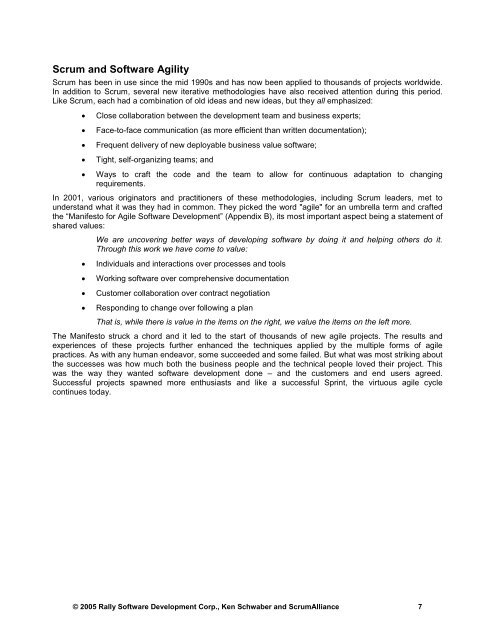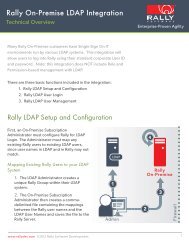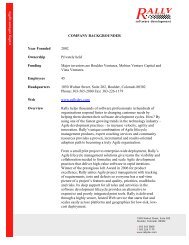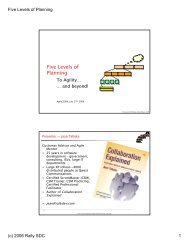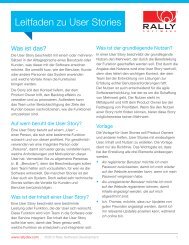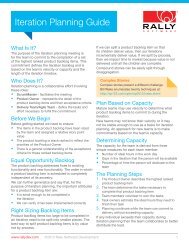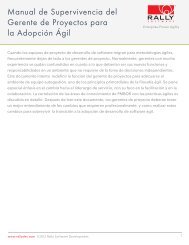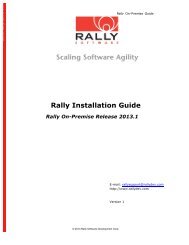Eliminate <strong>the</strong> Impediments So <strong>the</strong> Team Can Do its JobOver <strong>the</strong> years, a company’s organizational processes and s<strong>of</strong>tware development practices typically gainweight until building s<strong>of</strong>tware is <strong>of</strong>ten quite a difficult endeavor. When <strong>Scrum</strong> is implemented, <strong>the</strong>se“organizational impediments” to effective s<strong>of</strong>tware delivery become quite obvious, <strong>for</strong> <strong>the</strong>y get in <strong>the</strong> way <strong>of</strong><strong>the</strong> team’s ability to deliver on <strong>the</strong> rapid iterative, incremental nature <strong>of</strong> <strong>Scrum</strong>. Removing or changing <strong>the</strong>seprocesses and practices may show that a major change project must be initiated, driven and monitored by<strong>the</strong> CIO or executive champion (more on this topic later).Moreover, in <strong>Scrum</strong>, <strong>the</strong> team is <strong>the</strong> thing. After all, <strong>the</strong>y are <strong>the</strong> ones who actually design, develop anddeliver <strong>the</strong> application, so optimizing <strong>the</strong>ir per<strong>for</strong>mance by eliminating obstacles optimizes <strong>the</strong> business’sper<strong>for</strong>mance in delivering value to its users. Management does <strong>the</strong>ir job when <strong>the</strong>y eliminate impediments.The Team does its job when it meets its commitments as described in each Sprint’s Backlog.In o<strong>the</strong>r words, in <strong>Scrum</strong>, <strong>the</strong> team is both empowered and accountable to deliver <strong>the</strong> goods. The team does<strong>the</strong>ir job when <strong>the</strong>y self-organize, self-manage and self-achieve <strong>the</strong> objectives <strong>of</strong> <strong>the</strong> Sprint. For manyorganizations, this turns things upside down. The hierarchical-technical-management-directive approach isessentially eliminated with <strong>Scrum</strong>. The Product Owner now sets <strong>the</strong> objectives and priorities, <strong>the</strong> teamfigures out how to achieve <strong>the</strong>m, and no one need tell <strong>the</strong>m how to do that along <strong>the</strong> way.Better, Though Less Predictable Outcomes vs. False Confidence<strong>Scrum</strong> starts with <strong>the</strong> premise that creating s<strong>of</strong>tware is a complicated business operating in a highly-fluid andtechnical environment, and that no one can reliably predict or definitively plan exactly what a team willdeliver, when <strong>the</strong>y will deliver it, and what <strong>the</strong> quality and cost will be. Instead, <strong>Scrum</strong> understands thatteams can estimate <strong>the</strong>se items, communicate <strong>the</strong> estimates, negotiate a near term plan according tovarious risks and <strong>the</strong>n adjust as <strong>the</strong>y proceed. The agreement is that <strong>the</strong> team will deliver <strong>the</strong> best possibles<strong>of</strong>tware given <strong>the</strong> circumstances, and that following any cookbook approach won't improve <strong>the</strong> definition <strong>of</strong>"best,” and will only hinder <strong>the</strong> team’s responsiveness to <strong>the</strong> real-world complexity and unpredictability thatexists.Historically, ignoring this philosophy creates a number <strong>of</strong> organizational problems:Management actually believes that it can predict <strong>the</strong> cost, delivery schedule, and functionalitythat will be delivered, and plans accordingly.Developers and project managers are <strong>for</strong>ced to live a lie: <strong>the</strong>y pretend <strong>the</strong>y can plan, predict anddeliver. They build one way, but must pretend <strong>the</strong>y build ano<strong>the</strong>r way. In <strong>the</strong> end, <strong>the</strong>y areessentially without controls.By <strong>the</strong> time <strong>the</strong> system is delivered, it is <strong>of</strong>ten irrelevant or requires significant change. A keycause is that high iteration costs limit our visibility into <strong>the</strong> usefulness <strong>of</strong> what <strong>the</strong> team is actuallydeveloping, until it is too late.Recognizing <strong>the</strong>se realities is not without its challenges – <strong>for</strong> example, what manager wants to tell <strong>the</strong>irexecutive <strong>the</strong>y don’t know exactly what <strong>the</strong> team will deliver on <strong>the</strong> given date? But <strong>the</strong> benefits <strong>of</strong> thisapproach are that organizations are truly empowered: <strong>the</strong> business is finally free to produce better outcomes<strong>for</strong> its end users and will now do so more quickly, clearly creating competitive advantage <strong>for</strong> <strong>the</strong> business.© 2005 <strong>Rally</strong> S<strong>of</strong>tware Development Corp., Ken Schwaber and <strong>Scrum</strong>Alliance 6
<strong>Scrum</strong> and S<strong>of</strong>tware Agility<strong>Scrum</strong> has been in use since <strong>the</strong> mid 1990s and has now been applied to thousands <strong>of</strong> projects worldwide.In addition to <strong>Scrum</strong>, several new iterative methodologies have also received attention during this period.Like <strong>Scrum</strong>, each had a combination <strong>of</strong> old ideas and new ideas, but <strong>the</strong>y all emphasized:Close collaboration between <strong>the</strong> development team and business experts;Face-to-face communication (as more efficient than written documentation);Frequent delivery <strong>of</strong> new deployable business value s<strong>of</strong>tware;Tight, self-organizing teams; andWays to craft <strong>the</strong> code and <strong>the</strong> team to allow <strong>for</strong> continuous adaptation to changingrequirements.In 2001, various originators and practitioners <strong>of</strong> <strong>the</strong>se methodologies, including <strong>Scrum</strong> leaders, met tounderstand what it was <strong>the</strong>y had in common. They picked <strong>the</strong> word "agile" <strong>for</strong> an umbrella term and crafted<strong>the</strong> “Manifesto <strong>for</strong> Agile S<strong>of</strong>tware Development” (Appendix B), its most important aspect being a statement <strong>of</strong>shared values:We are uncovering better ways <strong>of</strong> developing s<strong>of</strong>tware by doing it and helping o<strong>the</strong>rs do it.Through this work we have come to value:Individuals and interactions over processes and toolsWorking s<strong>of</strong>tware over comprehensive documentationCustomer collaboration over contract negotiationResponding to change over following a planThat is, while <strong>the</strong>re is value in <strong>the</strong> items on <strong>the</strong> right, we value <strong>the</strong> items on <strong>the</strong> left more.The Manifesto struck a chord and it led to <strong>the</strong> start <strong>of</strong> thousands <strong>of</strong> new agile projects. The results andexperiences <strong>of</strong> <strong>the</strong>se projects fur<strong>the</strong>r enhanced <strong>the</strong> techniques applied by <strong>the</strong> multiple <strong>for</strong>ms <strong>of</strong> agilepractices. As with any human endeavor, some succeeded and some failed. But what was most striking about<strong>the</strong> successes was how much both <strong>the</strong> business people and <strong>the</strong> technical people loved <strong>the</strong>ir project. Thiswas <strong>the</strong> way <strong>the</strong>y wanted s<strong>of</strong>tware development done – and <strong>the</strong> customers and end users agreed.Successful projects spawned more enthusiasts and like a successful Sprint, <strong>the</strong> virtuous agile cyclecontinues today.© 2005 <strong>Rally</strong> S<strong>of</strong>tware Development Corp., Ken Schwaber and <strong>Scrum</strong>Alliance 7


